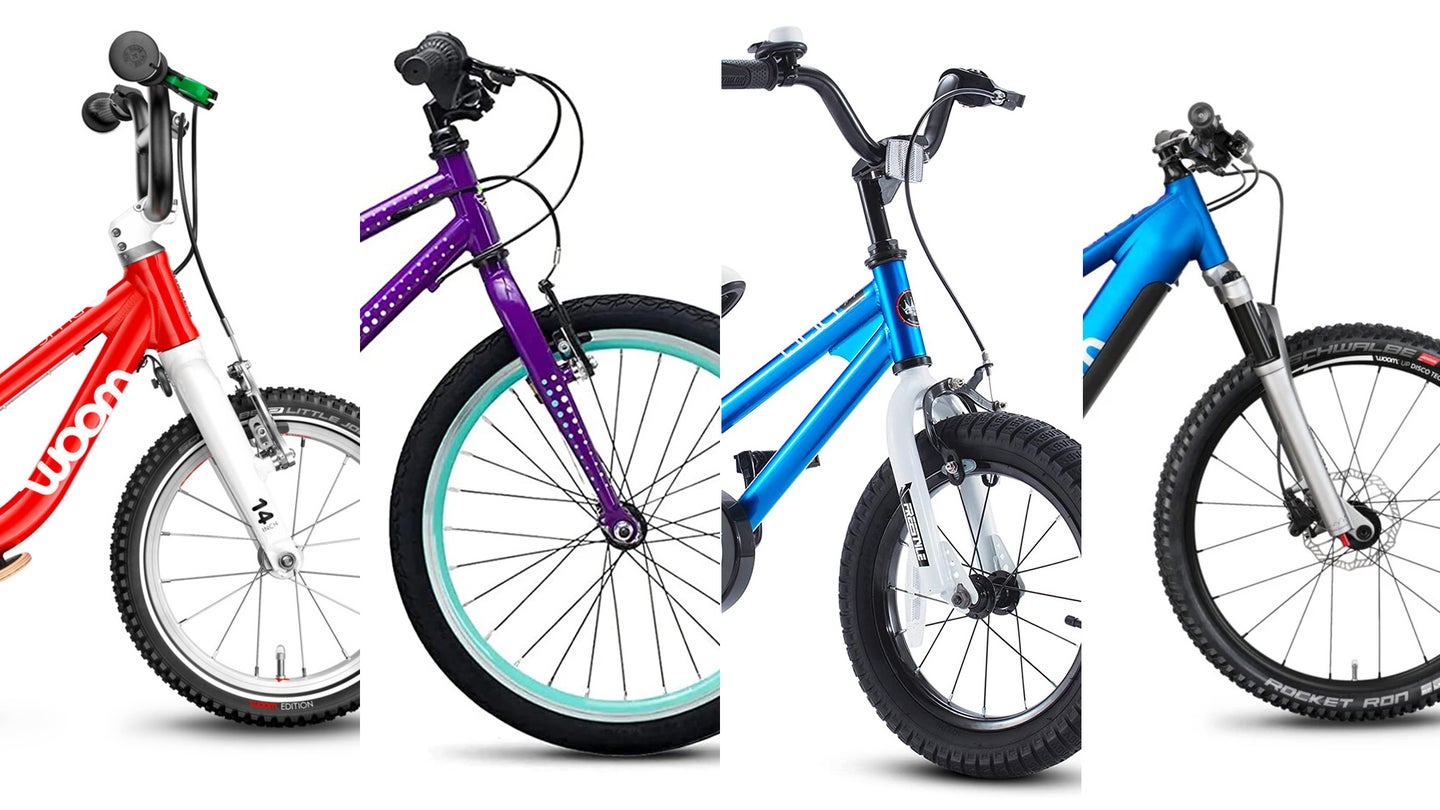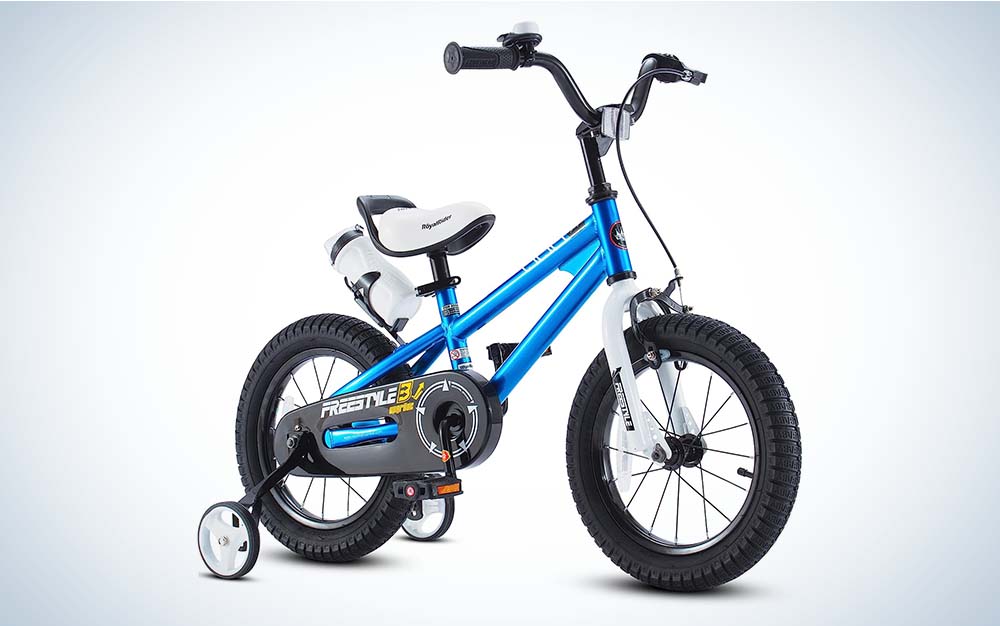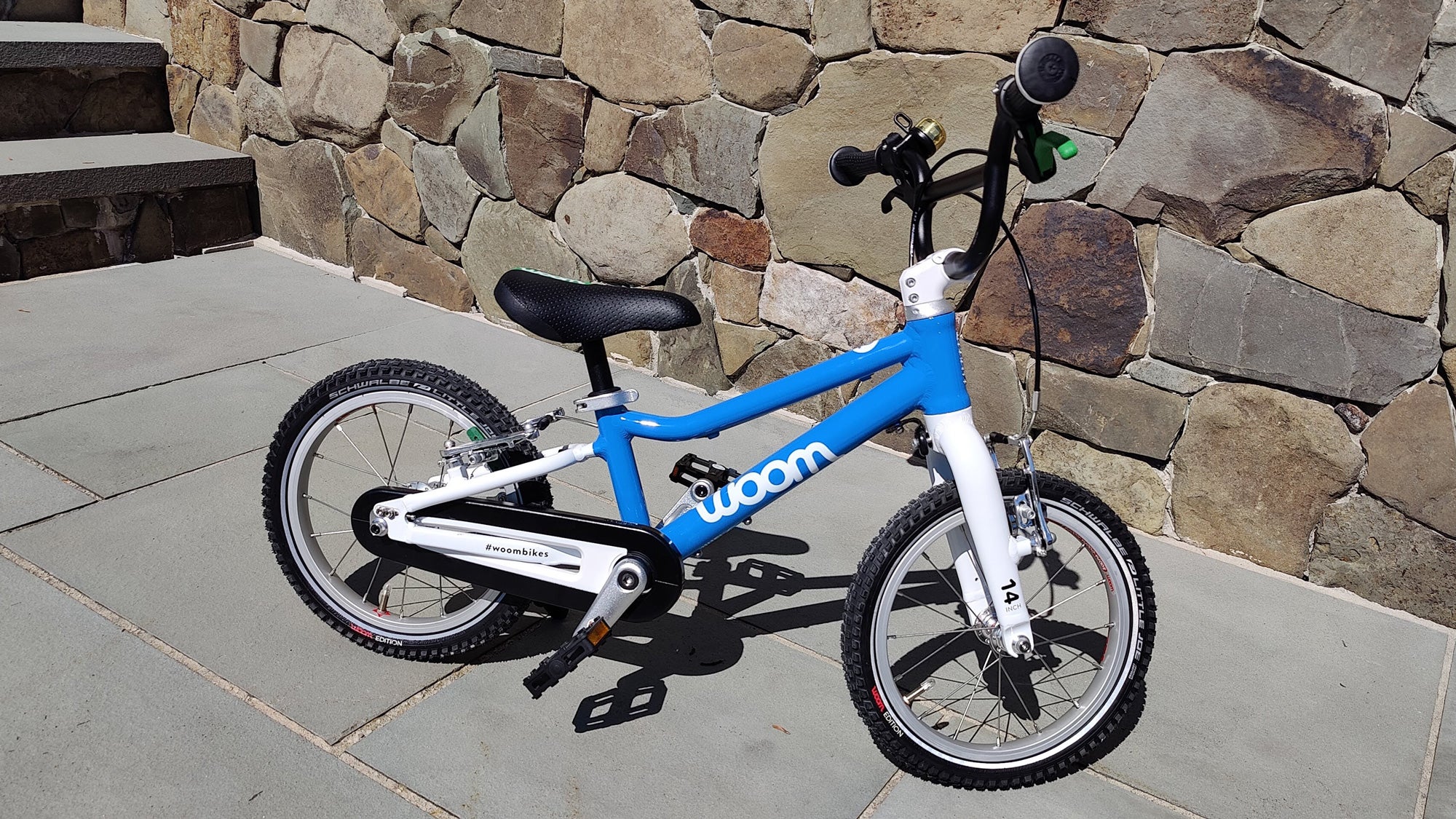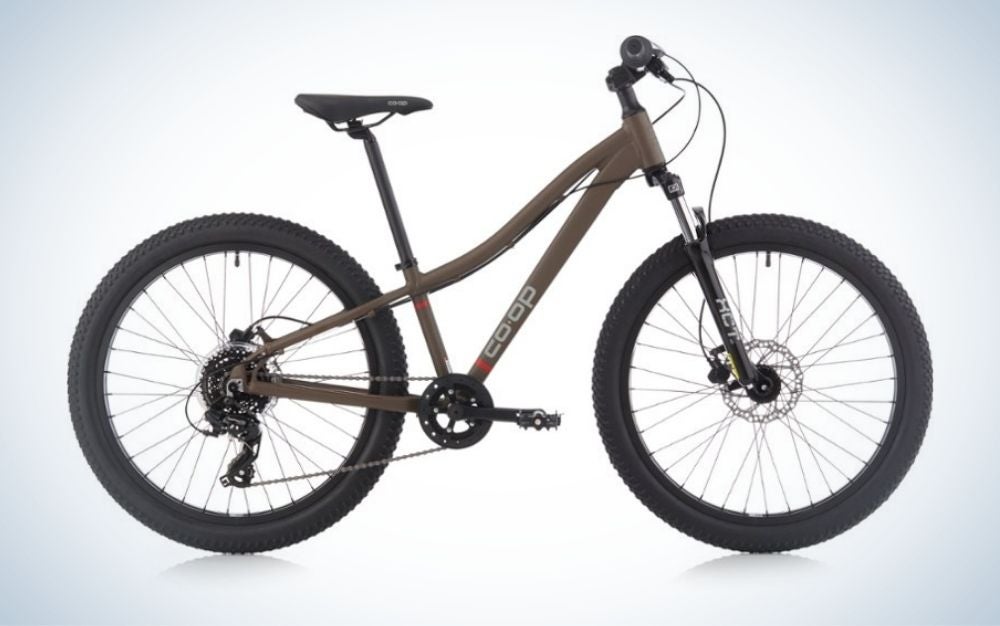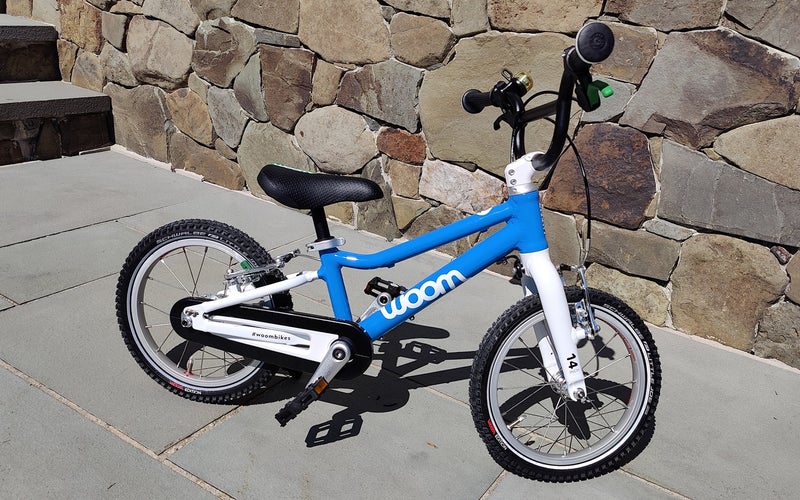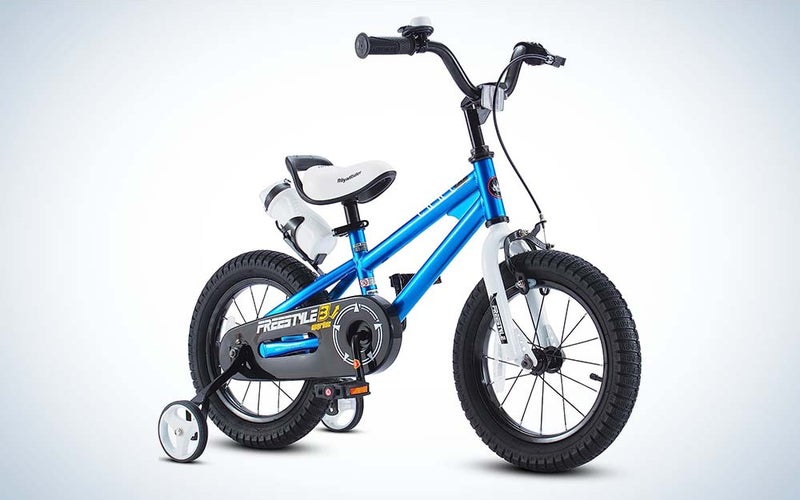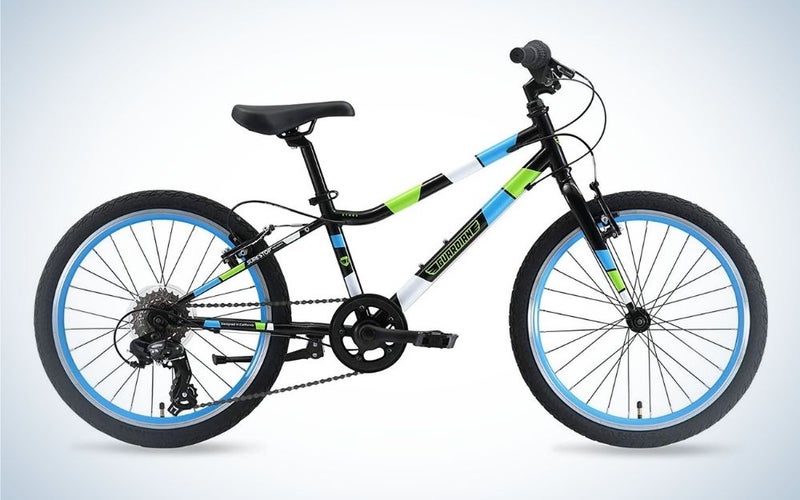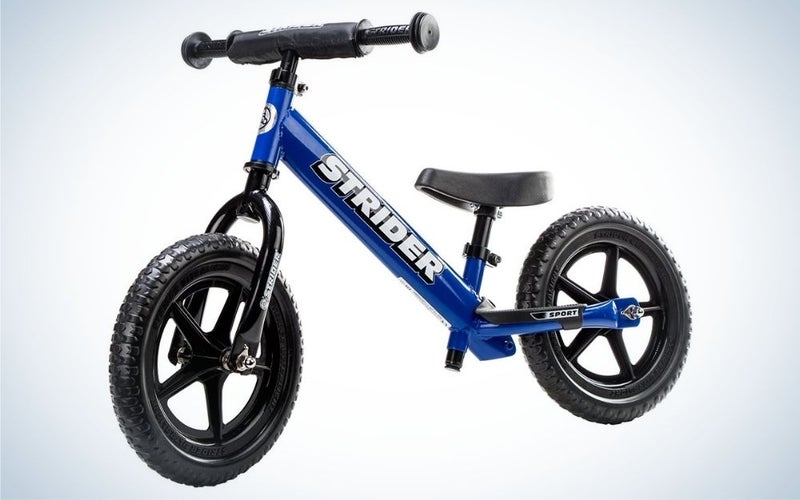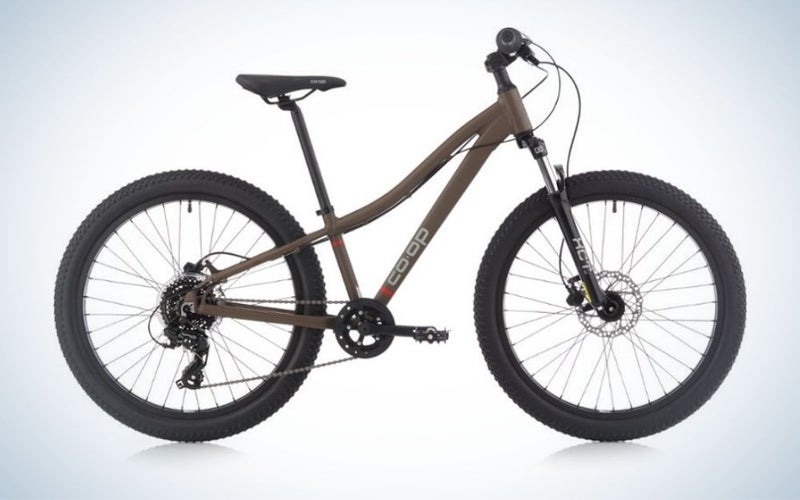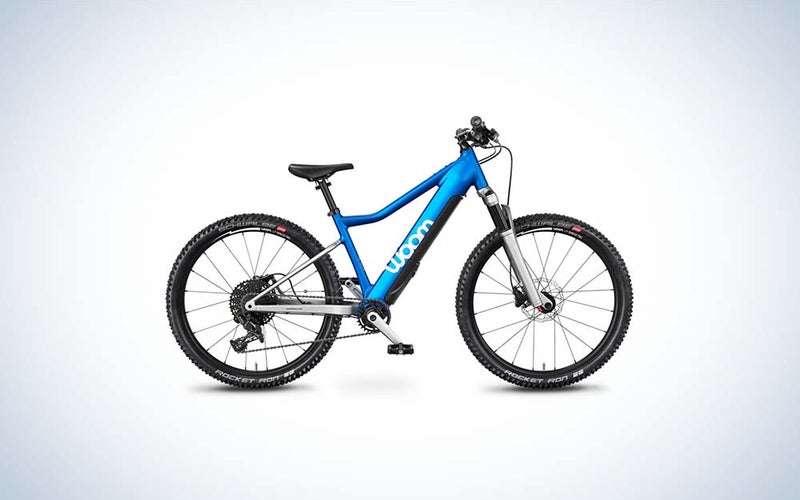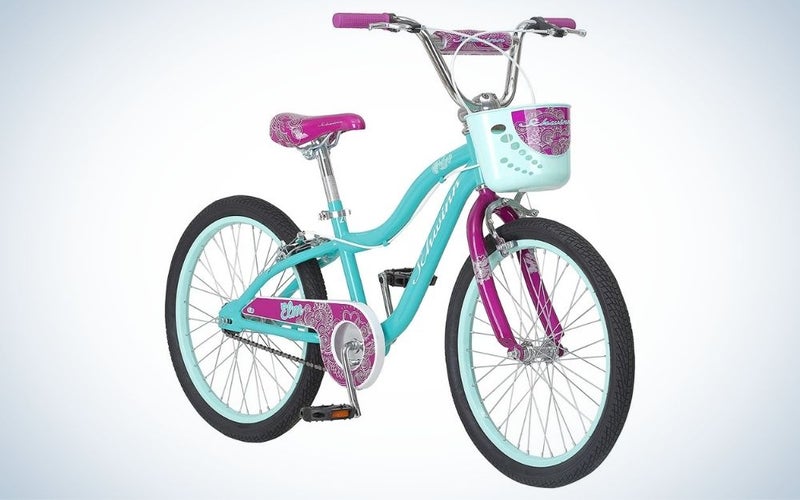We may earn revenue from the products available on this page and participate in affiliate programs. Learn more ›
When you’re a kid, getting a brand-new bike is the epitome of excitement and the ultimate sign of freedom. From riding around the block with friends to going for a quick family pedal on the weekends, a bike is a great marker for growing up and getting more independent. Whether your kids are starting on their first balance bike or getting ready to tackle tough terrain on a mountain bike, you’ll need to purchase a model that suits their size and experience. With so many options, it can be difficult to discern where to start. To help get you started, we’ve compiled a list of questions to consider, as well as some of our favorite picks, so that you can find the best kids’ bikes for your youngster.
- Best overall: Woom Original
- Best with training wheels: RoyalBaby Kids’ Bike
- Best hybrid: Guardian Bike Ethos
- Best balance bike: Strider 12 Sport Balance Bike
- Best mountain bike: Co-op Cycles’ REV DRT Bike
- Best electric: Woom Up 5
- Best budget: Schwinn Elm
How we chose the best kids’ bikes
While this might come as a surprise, we were all once kids … and we’re still a kid at heart when we get back on a bicycle. Using our lifetimes of insight, as well as more recent experience with our own children, we looked for good bikes for all ages of kids, from 18 months through the teenage years. We considered bikes from the best bicycle brands. And we looked for youth bikes that could grow with kids for a few years and serve a variety of needs and budgets.
The best kids’ bikes: Reviews & Recommendations
Learning to ride a bike is a rite of passage for kids. From their first wobbly rides on training wheels to shredding trails in the mountains, the right bike can provide adventure, exercise, and independence for your kids as they grow older.
Best overall: Woom Original
Mahesh Nair
Specs
- Ages: 3.5 up to 14 (depending on the size)
- Height: 31″ to 66″
- Wheel size: 12″, 14″, 16″, 20″, 24″, and 26″
- Gears: Single-speed or multi-gear, depending on size
Pros
- Ergonomically designed for kids’ frames
- Lightweight at 13 pounds
- Steering limiter makes riding safer
- Enclosed drivetrain keeps chain from dropping on smaller sizes
- Designed specifically for kids, not just retrofitted from bigger parts
Cons
- Pricy
Woom builds its bikes for kids from the ground up. These aren’t just shrunken-down versions of larger rides. We tested size 2, which is designed for kids between three and 4.5 years old. It can accommodate riders between 37″ and 43″ tall. The bike ships in a typical box and comes mostly assembled. Attaching the handlebars to the stem requires a simple hex wrench. Once that’s done, you simply attach the pedals, check all the bolts, and you’re basically ready to ride.
Everything on the bike is designed specifically to fit smaller riders. The anti-slip pedals are grippy but small, so they don’t stick out too far and gouge little legs. The grips employ an ergonomic shape that’s both comfortable and easier to hold onto when things get zesty. Even the brake levers are scaled down and shaped so they’re easy to reach and pull for little hands.

The single-speed drivetrain (bigger models for older kids employ a multi-gear system with a derailleur) is fully enclosed by a guard. This setup helps keep little fingers and lets away from the chain and sprockets. At the same time, it also drastically reduces the chances the bike will drop the chain while riding. That’s annoying and can be dangerous if the little rider doesn’t know how to handle it.
In terms of safety, the Woom 3 comes equipped with a steering delimiter that helps protect against oversteering. Lots of kid accidents come from overcorrecting and that’s not an issue here. The bikes are also very light, thanks in part to their aluminum frames. Many kids’ bikes rely on steel because it’s cheaper, but it’s heavy and prone to rusting.

These bikes are slightly pricy considering each size is only recommended for roughly two-year span. But they’re light, durable, and very well-made, so they should retain resale value or make great hand-me-downs if you have more kids to learn down the line.
Best with training wheels: RoyalBaby Kids’ Bike
Specs
- Ages: 4 to 7 years old
- Height: 33 to 37 inches
- Wheel size: 12, 14, and 16 inches
- Gears: Single speed
Pros
- Coaster brakes are easy to operate
- Training wheels are removable
- Adjustable seat
Cons
- Heavy
If you’re looking for a bike with training wheels, the RoyalBaby Kids’ Bike is an excellent option for kids learning how to ride a bike. The bike has a steel frame and weighs roughly 25 pounds. It comes with removable training wheels as kids learn how to ride, a hand brake, and back-pedal coaster brakes that make it easy for them to stop. The seat is adjustable and the 12-inch wheels are just right for beginning riders. Plus, it comes with a water bottle, a holder, a kickstand, and a bell. This bike also comes in seven colors and arrives mostly assembled.
Best hybrid bike: Guardian Bikes Ethos
Guardian Bikes
Specs
- Ages: 6 to 9
- Height: 43 to 53 inches
- Wheel size: 20 inches
- Gears: Six
Pros
- Designed to be ridden on range of terrains
- Six gears allow for more speed control
- Brakes designed with safety technology
Cons
- Some Amazon reviewers had issues with build quality
The Guardian Bikes Ethos is a bike that will do well for kids ready to ride on their own over various terrain types. Certainly a departure from the training wheel days of yore, the Guardian Ethos has six gears and a lightweight steel frame that provides extra stability. Designed for boys and girls from 45 to 53 inches tall, from ages 6 to 9, this bike has a sizing chart and video to make sure you get the perfect fit. It comes with a Surestop braking technology that controls both wheels with one brake lever for additional safety.
Best balance bike: Strider 12 Sport Balance Bike
Strider
Specs
- Ages: 18 months to 5 years
- Height: 12 to 20 inches
- Wheel size: 11 inches
- Gears: Single speed
Pros
- Seat and handlebar adjust easily
- Lightweight
- Tires are puncture-proof
Cons
- No written instructions for assembly included
The Strider 12 Sport is a great way to introduce biking fundamentals to your little one. Suitable for kids as young as 18 months, this is one bike that will safely grow with your child. The seat and handlebars are adjustable to accommodate an inseam that measures anywhere between 12 and 20 inches. The bike itself weighs under seven pounds which is manageable for small children, and mini-grips will help them keep control. The steel frame is durable, and the tires are puncture-proof; all you need is a helmet, and your child will be ready for a super-safe spin. Available in 10 fun colors, the 12 Sport will introduce your child to the freedom, power, and responsibility that comes with riding their first bike.
Best mountain bike: Co-op Cycles’ REV DRT Bike
Co-op Cycles
Specs
- Ages: Tweens and teens
- Height: N/A
- Wheel size: 24 inches
- Gears: 8
Pros
- Suspension fork minimizes jolting on rough terrain
- Comes with hydraulic disc brakes
- Extra-wide tires
Cons
- Expensive
- Heavy
If you’re looking for a specialized kids’ bike, the REV DRT Bike tops the chart when it comes to kids’ mountain bikes. The lightweight aluminum frame, extra-wide tires, hydraulic disc brakes, and suspension fork with 80 millimeters of travel will ensure your child can navigate rocky trails with ease. This bike is equipped with eight gears to give your kid plenty of options for climbing steep passages or coasting downhill. Weighing in at 31 pounds with 24-inch wheels, this bike is undoubtedly meant for older, more experienced riders. If the 24-inch wheels are a bit too big for your kids, you can check these bikes from Prevolo, which are designed to help kids of any size on any terrain. For more fun, check out the best dirt bikes for kids.
Best electric: Woom Up 5
Woom
Specs
- Ages: 7 to 11
- Height: 50 to 57 inches
- Wheel size: 24 inches
- Gears: 11
Pros
- Pedal assist up to 12 miles per hour
- Allows for 11 speeds
- Rugged tires
- Electric blue color
Cons
- Expensive
- Potential danger of battery
Got a kid who’s already tearing up the gravel? An electric bike would be a significant upgrade. The Woom Up 5 is designed for both mountain trails and commuting to school and can kick in just when your child is getting tired. With its lightweight aluminum frame, this bike has a range of 11 speeds. The 250-watt Fazua motor allows for three levels of pedal assist up to 12 miles per hour, but you can also remove the motor and battery when kids want to ride solely on their own steam. The associated app allows your child to track mileage, speed, and battery charge. And the removable lithium ion battery has a capacity of 250 watt-hours, the allowable limit.
The frame and saddle are ergonomically designed to fit kids’ frames and the hydraulic air suspension fork provides cushion against bumps in the road. The durable tires are designed for mountain biking, with strong grip and shock absorption. The Woom Up 5 also comes with Promax hydraulic disc brakes and handlebar grips designed for kids’ hands. Along with the bike, you’ll also receive tools to assemble it and a battery charger. For more motorized fun, check out the best kids’ ATVs.
Best budget: Schwinn Elm
Schwinn
Specs
- Ages: 7 to 13
- Height: 48 to 62 inches
- Wheel size: 20 inches
- Gears: Single speed
Pros
- Affordable
- Comes with a basket
- Available in wheel sizes from 12 to 20 inches
Cons
- Only one speed
- May be too basic for older kids
Finding a safe, sturdy, budget-friendly kid’s bike can be a bit of a challenge, and of course, the bigger the bike, the bigger the price tag. The Schwinn Elm is available in multiple wheel sizes, including 12, 14, 16, 18, and 20 inches. Though not every size is available for under $150, each model is certainly on the inexpensive side of the kids’ bike spectrum. Each Schwinn Elm is designed with a light frame, coaster brakes, and one front-hand (or caliper brake) to help ease the transition to a full-size model. The seats are adjustable, with a forward, narrow pedal position to fit their bodies. The Elm comes in three different colors, featuring pink, purple, and light blue floral patterns and a basket on the front. For a more rugged aesthetic but almost identical specs, check out the Schwinn Koen.
Things to consider before buying the best kids’ bike
The best kids’ bikes will vary depending on your child’s height, weight, and skill level. Generally speaking, you’ll be looking for bikes by seat height or wheel size between 12 and 24 inches, which will correlate to your kid’s age, height, and inseam. Beyond size, the next thing to consider is your kid’s skill level: Do they need training wheels, fixed gear, or a mountain bike? While all these components are simple enough, take the time to make sure your measurements are correct, and whether a classic pick of one of the specialized children bikes is appropriate.
Size
The easiest way to determine what size bike your kid needs is to measure their inseam (from where their feet touch the ground to the top of their crotch). Once you determine this number, you want to look for a bike with a seat height that is, at minimum, this number. For example, if your little one’s inseam measurement is 19 inches, then 19 inches should be the minimum seat height on their bike. As a child is learning to ride, they should be able to place their feet on the floor securely, so the correct seat height will keep them in control as they learn to manipulate hand breaks, etc. From there, you can consider wheel size and frame weight.
Wheel size
Aside from seat height, there are a few other measurements you can take into account to determine the proper wheel size for your kid’s new bike. Here is a rough guide you can use to narrow your search:
A child ages 2-4 between 30-39 inches tall with a 12-17-inch inseam will need a bike with 12-inch wheels. Children ages 3-5 between 37-44 inches tall with a 16-20-inch inseam will need a bike with 14-inch wheels. Next, a little one aged 5-8 between 42-52 inches tall with an 18-22-inch inseam will need a bike with 20-inch wheels. Finally, a kid who is 8-12 years old, 50-58 inches tall with a 24-28-inch inseam will probably do best on a 24-inch wheeled bike.
Before purchasing, make sure you double-check the seat height, and before you know it, your little cyclist will be ready to roll on one of the best bikes for kids.
Child’s weight
It’s important to consider your child’s weight in relation to the weight of the bike. Kids’ bikes typically weigh between 25 and 45 percent of their body weight, which is a lot when you consider that most adult bikes weigh around 20 percent or less of their rider’s total body weight. If the frame is too heavy, your child will have trouble controlling their bike; they won’t be able to pedal properly, and steering may become a challenge. If possible, try to select a bike that weighs at or below 30 percent of their body weight, so they can get stronger while riding without struggling through the process.
Experience
If you have a young child under four, consider trying out a balance bike before going straight for the pedals. As your child learns more about their center of gravity, a balance bike can help familiarize them with the concept of coordination, steering, and stopping. Instead of a traditional break and chain, they’ll use their feet to break as well as to propel themselves forward. A balance bike will help prepare them to pedal, and as soon as they are old enough, you can transition them to training wheels or skip them altogether. Many kids who start on a balance bike can transition straight to a two-wheel model.
Durability
Supplying your child with everything they need can be expensive, especially when they’re constantly outgrowing clothes, toys, car seats, and more. Depending on size, kids’ bikes can run you between $175 and $400, a pretty penny when it comes to something they will eventually be too big to use. While it can certainly be tempting to buy a bike that your kid will be able to grow into, a bike that’s too big can be dangerous, not to mention hard to use. It will be hard for them to reach the handlebars or touch the ground with their feet during a stop. What’s more, the extra weight will make it hard to pedal and they may get into more accidents. Instead, consider looking for a budget-friendly kids’ bike, or go to a reliable reseller. Well-maintained, used bikes work well, and your child will have an easier time riding, gaining confidence and strength on a bike that suits their proportions.
Single speed v. multiple gears
Single-speed bikes are less complicated than a bike with multiple gears. They’re great for those who have just taken off the training wheels and are focused on flat ground. A single-speed bike will let your kid get used to hand brakes, which are typically introduced with 20-inch models. Of course, single-speed models can definitely present a challenge for navigating tricky terrain or getting up hills. If your child has had the training wheels off for a while, they may be ready to try a bike with multiple gears.
If you’re training a little mountain biker, learning how to use gears properly will be especially important. Mountain bikes are generally wider, with larger, deeply treaded tires and front shocks to absorb the impact of rough terrain. They have more low gears to help your off-road adventurer climb steep hills.
If you want a multi-gear bike, but you aren’t necessarily heading into the mountains, you can go for a hybrid bike, which features an array of gears suitable for roads, hilly bike paths, low-impact groomed trails, and more.
FAQs
Q: How tall should a child be to ride a 20-inch bike?
Generally, a child should be between 42 and 52 inches tall to ride a 20-inch bike. However, you need to calculate their inseam and compare that to the bike’s seat height before settling on a 20-inch model. You also want to make sure they can easily reach the handlebars; at 20 inches, hand brakes are introduced to the bike design.
Q: What age can a child ride a bike without stabilizers?
Stabilizers, or training wheels, help children get comfortable on a bike, preventing them from falling over and letting them focus on braking, steering, and speed. Statistically, kids will learn to ride a bike without any extra stabilization anywhere between 4 and 9 years old. There’s no set age at which training wheels should be removed, so you’ll want to monitor your child’s confidence on their stabilized bike and look for signs they may be ready to remove the supports.
Q: What age is an 18-inch bike for?
An 18-inch bike can be suitable for many ages depending on height and leg size. An inseam between 20-24 inches and a height slightly under four feet is usually suitable for an 18-inch bike. These measurements are traditionally attributed to kids ages 5 or 6, though any child this size can be comfortable riding an 18-inch bike.
Final thoughts on buying the best kids’ bike
- Best overall: Woom Original
- Best with training wheels: RoyalBaby Kids’ Bike
- Best hybrid: Guardian Bike Ethos
- Best balance bike: Strider 12 Sport Balance Bike
- Best mountain bike: Co-op Cycles’ REV DRT Bike
- Best electric: Woom Up 5
- Best budget: Schwinn Elm
Giving a kid their first bike is a fantastic rite of passage for all parties involved, a gift that represents fun, freedom, and future adventures. So whether they’re starting to toddle around on balance bikes or racing you down the trail on a mountain bike, pay particular attention to their height and inseam measurements before purchasing. As long as the bike fits their body and skill level, you can have as much fun as you want choosing the color, bike bell, and any other gear they may need—just make sure you include a helmet.
Why trust us
Popular Science started writing about technology more than 150 years ago. There was no such thing as “gadget writing” when we published our first issue in 1872, but if there was, our mission to demystify the world of innovation for everyday readers means we would have been all over it. Here in the present, PopSci is fully committed to helping readers navigate the increasingly intimidating array of devices on the market right now.
Our writers and editors have combined decades of experience covering and reviewing consumer electronics. We each have our own obsessive specialties—from high-end audio to video games to cameras and beyond—but when we’re reviewing devices outside of our immediate wheelhouses, we do our best to seek out trustworthy voices and opinions to help guide people to the very best recommendations. We know we don’t know everything, but we’re excited to live through the analysis paralysis that internet shopping can spur so readers don’t have to.
